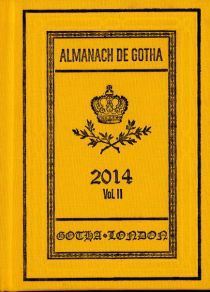In the Almanach de Gotha
By ADRIAN TAHOURDIN
The great French painter Nicolas de Staël (1914–55), when asked about his family antecedents, was said to casually reply “Have a look at the Gotha”. He was referring to the Almanach de Gotha, the directory of European aristocracy.
The Staëls emerged from Holstein in Germany, from where they migrated via Sweden to St Petersburg. The painter’s father was vice-governor of the Peter and Paul Fortress in St Petersburg at the time of the Revolution, and the family was forced to flee Russia in 1919, when Nicolas was five years old. Nicolas spent part of his childhood in Belgium before moving to Paris in his twenties, where he more or less settled (“settling” being a relative concept in his restless life, which might explain why Staël only took out French citizenship relatively late in his short life). His centenary was marked by two exhibitions in France last year.
The family of another Russian exile, Nicholas Romanov, followed a similar trajectory: they too fled the country in 1919. Nicholas was born in 1922 in Cap d’Antibes (which, coincidentally, was where Staël committed suicide at the age of forty-one) in the South of France, and died in September last year. His father Prince Roman Petrovich of Russia was cousin to Tsar Nicholas II. Nicholas Romanov was, according to his obituary in the Times, “the stateless head of Russia’s former ruling family”, and a republican.

Nicholas Romanov – Lehtikuva Oy/Rex Features
Nicholas Romanov can, of course, be found in the 2014 (and 191st) edition of the Almanach de Gotha, under “Russia (House of Romanov/Romanoff)”. He was resident in Livorno, Italy. According to the Times obit, Romanov hosted the launch of the 2003 Almanach in London, when “he was at pains to point out that admittance to its pages was not a foregone conclusion. ‘Southern Italy is full of dukes . . . Very nice families, but there are millions of them. And the Almanach has always been careful with Portuguese dukes’”.
There can be no such doubts about the Duchess of Alba, who was born in 1926 and died last November. The Times, again, referred to her “unmatched collection of titles, fabulous wealth and colourful love life” as well as calling her “one of Europe’s most eccentric aristocrats”. She was a “descendant of King James II”: “had the . . . Scottish referendum ended differently, her connection to the Stuart dynasty would have given her a claim to the Scottish throne”. Apparently “she owned so many estates that it was said she could travel from the northernmost point of Spain down to the south coast without ever stepping off her own land”.
There she is on p153 of Vol II: “Maria del Rosario CAYETANA Paloma Alfonsa Victoria Eugenia Fernanda Teresa Francisca de Paula Lourdes Antonia Josefa Fausta Rita Castor Dorotea Santa Esperanza Fitz-James Stuart y de Silva, 11TH DUCHESS OF BERWICK, 18TH DUCHESS OF ALBA DE TORMES, Almazán, Liria and Jérica, Aliaga, Arjona, Hijar, Jerica, Montoro, Countess and Duchess of Olivares, Marchioness of the Carpio, San Vicente del Barco, La Algaba, Almenara, Barcarrota, Castañeda, Coria, Eliche, Mirallo, Mota, Moya, Orani, Osera, San Leonardo, Sarria, Tarazona, Valdunquillo, Villanueva del Fresno, Villanueva del Río, Countess of Aranda, Lemos, Lerín, Miranda del Castañar, Monterrey, Osorno, Palma del Río, Salvatierra, Siruela, Andrade, Ayala, Casarrubios del Monte, Fuentes de Valdepero, Fuentidueña, Galvi, Gelves, Guimerá, Modica, Ribadeo, San Esteban de Gormaz, Santa Cruz de la Sierra, Tinmouth, Villalba, Viscountess of la Calzada, Baroness of Bosworth, Lady of Moguer, Grandee of Spain 1st Cl.”
Prince David Chavchavadze (who also died in November 2014), meanwhile, was descended from both the Russian and (as his surname suggests) Georgian royal houses and ended up working for the fledgling CIA after the war. He seems to have been a particularly colourful character (the photo accompanying the Times obit shows him in what looks like traditional Georgian warrior dress in 1999) who “performed [Russian folk tunes] professionally” in Washington. The name Chavchavadze (Chav for short, perhaps?) appears in the index, but I can find no David on the relevant page – I’m not yet very adept at consulting the Almanach, clearly.
That’s quite a trio of European royals we've recently lost. And, while on the subject, I learnt from the Almanach that there are ten surviving royal houses in Europe – can you name them? (I should say that I’m neither royalist nor republican, just a fence-sitter who thinks that royals can add to the gaiety of nations.)
The Almanach is a monumental publication, 2,700 closely printed pages spread across two volumes, but I guess it doesn’t have to update to quite the extent of its fellow publication the Wisden Cricketers’ Almanack, which annually publishes records of hundreds if not thousands of cricket matches played around the world in the preceding year.
Reviewing the last Gotha in the TLS (October 5, 2012 – it’s a long way from being an annual publication), the historian David Gelber wrote of how it “became a handbook for husband-hunters, fortune-seekers, pedants and pretenders”. Yet “its punctilious itemization of titles, lineage and heraldry aims for scholarship rather than sensation”.
I didn’t know the Almanach included a 500-page country-by-country gazetteer. It’s sobering to discover from it that the death penalty is retained in (by my calculations) 100 countries across the world, including Japan – even if the information is occasionally qualified with the phrase “not used since . . .”.
Peter Stothard's Blog
- Peter Stothard's profile
- 30 followers




